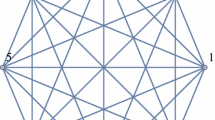Abstract
In this paper, we consider an extended coined Szegedy model and discuss the existence of the point spectrum of induced quantum walks in terms of recurrence properties of the underlying birth and death process. We obtain that if the underlying random walk is not null recurrent, then the point spectrum exists in the induced quantum walks. As an application, we provide a simple computational way of the dispersion relation of the edge state part for the topological phase model driven by quantum walk using the recurrence properties of underlying birth and death process.

Similar content being viewed by others
Notes
The stationary state exists and is proportion to \(1/E(T_j)\).
References
Asboth, J.K., Edge, J.M.: Edge-state-enhanced transport in a two-dimensional quantum walk. Phys. Rev. A 91, 022324 (2015)
Cantero, M.J., Grünbaum, F.A., Moral, L., Velázquez, L.: Matrix valued Szegö polynomials and quantum walks. Commun. Pure Appl. Math. 63, 464–507 (2010)
Durrett, R.: Probability: Theory and Examples. Cambridge University Press, Cambridge (1990)
Endo, T., Konno, N., Obuse, H., Segawa, E.: Sensitivity of quantum walks to boundary of two-dimensional lattices: approaches from the CGMV method and topological phases. J. Phys. A Math. Theor. 50, 455302 (2017)
Ho, C.-L., Ide, Y., Konno, N., Segawa, E., Takumi, K.: A spectral analysis of discrete-time quantum walks with related to birth and death chains. J. Stat. Phys. 171, 207–219 (2018)
Higuchi, Yu., Konno, N., Sato, I., Segawa, E.: Spectral and asymptotic properties of Grover walks on crystal lattices. J. Funct. Anal. 267, 197–235 (2014)
Higuchi, Yu., Portugal, R., Sato, I., Segawa, E.: Eigenbasis of the evolution operator of 2-tessellable quantum walks. Linear Algebra Appl. 583, 257–281 (2019)
Higuchi, Yu., Segawa, E.: Quantum walks induced by Dirichlet random walks on infinite trees. J. Phys. A Math. Theor. 51, 075303 (2018)
Igarashi, D., Obata, N.: Asymptotic spectral analysis of growing graphs: odd graphs and spidernets. Banach Center Publ. 73, 245–265 (2006)
Konno, N., Portugal, R., Sato, I., Segawa, E.: Partition-based discrete-time quantum walks. Quantum Inf. Process. 17(4), 100 (2018)
Matsue, K., Ogurisu, O., Segawa, E.: A note on the spectral mapping theorem of quantum walk models. Interdiscip. Inf. Sci. 23, 105–114 (2017)
Ohno, H.: Unitary equivalence classes of one-dimensional quantum walks II. Quantum Inf. Process. 16, 287 (2017)
Portugal, R.: Staggered quantum walks on graphs. Phys. Rev. A 93, 062335 (2016)
Portugal, R.: Quantum Walks and Search Algorithms, 2nd edn. Springer, Berlin (2018)
Segawa, E.: Localization of quantum walks induced by recurrence properties of random walks. J. Comput. Theor. Nanosci. Theor. Math. Aspects Discrete Time Quantum Walk 10, 1583–1590 (2013)
Schinazi, R.B.: Classical and Spatial Stochastic Processes, Birkhäuser (1999)
Segawa, E., Suzuki, A.: Generator of an abstract quantum walk. Quantum Stud. Math. Found. 3, 11–30 (2016)
Szegedy, M.: Quantum speed-up of Markov chain based algorithms. In: Proceedings of 45th IEEE Symposium on Foundations of Computer Science, 32–41 (2004)
Acknowledgements
YI was supported by the Grant-in-Aid for Young Scientists (B) of Japan Society for the Promotion of Science (Grant No. 16K17652). ES acknowledges financial support from the Grant-in-Aid of Scientific Research (C) Japan Society for the Promotion of Science (Grant No. 19K03616).
Author information
Authors and Affiliations
Corresponding author
Additional information
Publisher's Note
Springer Nature remains neutral with regard to jurisdictional claims in published maps and institutional affiliations.
Appendix A: computation of \(\ker (C_j+ie^{i\phi })\)
Appendix A: computation of \(\ker (C_j+ie^{i\phi })\)
The \((-ie^{i\phi })\)-eigenvector of \(C_j\) is expressed by
Recall that \(\cos \phi =\kappa =\mathrm {Im}(\eta _j)\) and \(e^{i\phi }=\kappa +i\sqrt{1-\kappa ^2}\). Then, each element of the eigenvector can be deformed by
respectively. Here we put
Therefore the normalized eigenvector is expressed by
where
Rights and permissions
About this article
Cite this article
Ide, Y., Konno, N. & Segawa, E. Eigenvalues of quantum walk induced by recurrence properties of the underlying birth and death process: application to computation of an edge state. Quantum Inf Process 20, 160 (2021). https://doi.org/10.1007/s11128-021-02999-0
Received:
Accepted:
Published:
DOI: https://doi.org/10.1007/s11128-021-02999-0




